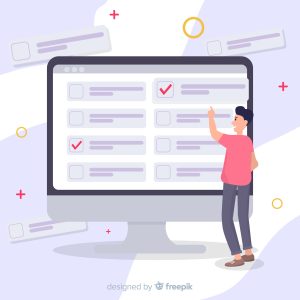E-learning is one example of how the digital age has resulted in a new era in the way that people learn, one that sees a change away from the more static and passive practises that were previously used. The introduction of scenario-based games into these digital platforms is a critical factor that contributes to their success. These game scenarios not only keep users engaged but also considerably improve the learning experience they have.
Let’s go a step further and see how you might include these interactive gaming scenarios in the content of your e-learning course.

Objectives
The monotony of traditional learning methods needs to be broken up, and the primary goal of the implementation of e-learning game scenarios is to encourage more active user participation. We wish to encourage cognitive engagement and strengthen people’s abilities to think critically. The goals of your game should be in line with the learning outcomes, whether those targets are the acquisition of practical business skills, the mastery of a new language, or the understanding of difficult scientific topics.
Rules and Requirements
To make sure that everyone has a good time while they’re learning, the rules need to be clear and easy to understand. For instance, a language learning game may demand the learner to match words with their meanings within a set time restriction. Alternately, a business simulation game could require the player to make tactical choices in order to successfully manage a fictional corporation. The level of difficulty ought to be made progressively tougher in order to keep the learners’ interest and to challenge them.
Creating the Game
Start by determining the learning outcomes and developing a game that can naturally lead to these outcomes. Incorporate a variety of activities such as quizzes, puzzles, or memory games to cater to different learning styles.
Putting Together the Game
Start by determining the learning outcomes and developing a game that can naturally lead to these outcomes. Incorporate a variety of activities such as quizzes, puzzles, or memory games to cater to different learning styles.
Incorporate a variety of activities such as quizzes, puzzles, or memory games to cater to different learning styles.
- Set specific objectives that match the course material.
- Devise a compelling storyline that includes educational material in a way that is both entertaining and interesting.
- Develop the game mechanics. Make sure the rules are easy to understand yet still demanding, and that the level of difficulty increases as the learner’s ability does.
- Implement feedback methods, like scores, badges, or progress bars, to reward and engage learners.
- Finally, test the game thoroughly, get user feedback, and make any improvements to enhance the learning experience.
Expected Results and Learning Outcomes
The anticipated results as well as the educational outcomes
E-learning game scenarios that are executed correctly have the potential to lead to higher user engagement, improved knowledge retention, and improved problem-solving skills. They provide learners with a platform that is both entertaining and interesting, allowing them to take in information at their own pace, which ultimately results in a more profound comprehension of the topic.
In conclusion, interactive gaming scenarios are a modern method that will revolutionise the e-learning industry. At Inelso eLearning Solutions, we are dedicated to leveraging the power of these gaming scenarios so that we can provide everyone with a learning experience that is more engaging, more effective, and more pleasant.

